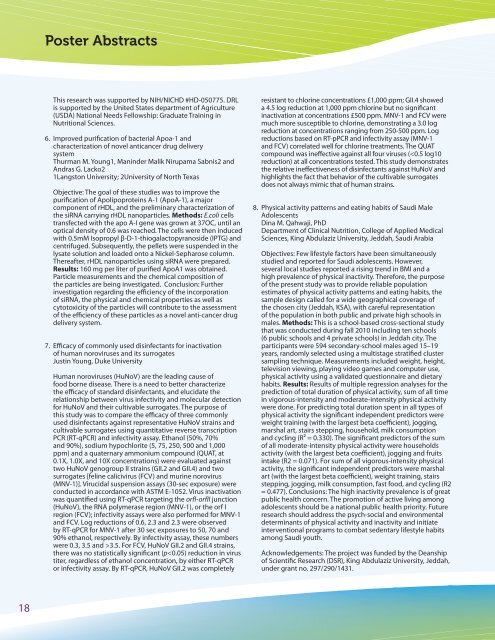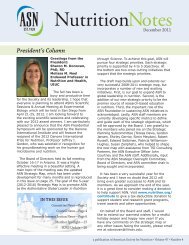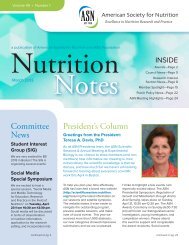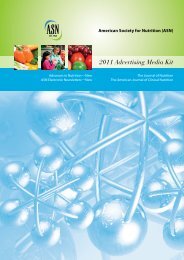Onsite Program & Exhibit Guide - Amazon Web Services
Onsite Program & Exhibit Guide - Amazon Web Services
Onsite Program & Exhibit Guide - Amazon Web Services
Create successful ePaper yourself
Turn your PDF publications into a flip-book with our unique Google optimized e-Paper software.
18<br />
Poster Abstracts<br />
This research was supported by NIH/NICHD #HD-050775. DRL<br />
is supported by the United States department of Agriculture<br />
(USDA) National Needs Fellowship: Graduate Training in<br />
Nutritional Sciences.<br />
6. Improved purification of bacterial Apoa-1 and<br />
characterization of novel anticancer drug delivery<br />
system<br />
Thurman M. Young1, Maninder Malik Nirupama Sabnis2 and<br />
Andras G. Lacko2<br />
1Langston University; 2University of North Texas<br />
Objective: The goal of these studies was to improve the<br />
purification of Apolipoproteins A-1 (ApoA-1), a major<br />
component of rHDL, and the preliminary characterization of<br />
the siRNA carrying rHDL nanoparticles. Methods: E.coli cells<br />
transfected with the apo A-I gene was grown at 37OC, until an<br />
optical density of 0.6 was reached. The cells were then induced<br />
with 0.5mM Isopropyl β-D-1-thiogalactopyranoside (IPTG) and<br />
centrifuged. Subsequently, the pellets were suspended in the<br />
lysate solution and loaded onto a Nickel-Sepharose column.<br />
Thereafter, rHDL nanoparticles using siRNA were prepared.<br />
Results: 160 mg per liter of purified ApoA1 was obtained.<br />
Particle measurements and the chemical composition of<br />
the particles are being investigated. Conclusion: Further<br />
investigation regarding the efficiency of the incorporation<br />
of siRNA, the physical and chemical properties as well as<br />
cytotoxicity of the particles will contribute to the assessment<br />
of the efficiency of these particles as a novel anti-cancer drug<br />
delivery system.<br />
7. Efficacy of commonly used disinfectants for inactivation<br />
of human noroviruses and its surrogates<br />
Justin Young, Duke University<br />
Human noroviruses (HuNoV) are the leading cause of<br />
food borne disease. There is a need to better characterize<br />
the efficacy of standard disinfectants, and elucidate the<br />
relationship between virus infectivity and molecular detection<br />
for HuNoV and their cultivable surrogates. The purpose of<br />
this study was to compare the efficacy of three commonly<br />
used disinfectants against representative HuNoV strains and<br />
cultivable surrogates using quantitative reverse transcription<br />
PCR (RT-qPCR) and infectivity assay. Ethanol (50%, 70%<br />
and 90%), sodium hypochlorite (5, 75, 250, 500 and 1,000<br />
ppm) and a quaternary ammonium compound (QUAT, at<br />
0.1X, 1.0X, and 10X concentrations) were evaluated against<br />
two HuNoV genogroup II strains (GII.2 and GII.4) and two<br />
surrogates [feline calicivirus (FCV) and murine norovirus<br />
(MNV-1)]. Virucidal suspension assays (30-sec exposure) were<br />
conducted in accordance with ASTM E-1052. Virus inactivation<br />
was quantified using RT-qPCR targeting the orfI-orfII junction<br />
(HuNoV), the RNA polymerase region (MNV-1), or the orf I<br />
region (FCV); infectivity assays were also performed for MNV-1<br />
and FCV. Log reductions of 0.6, 2.3 and 2.3 were observed<br />
by RT-qPCR for MNV-1 after 30 sec exposures to 50, 70 and<br />
90% ethanol, respectively. By infectivity assay, these numbers<br />
were 0.3, 3.5 and >3.5. For FCV, HuNoV GII.2 and GII.4 strains,<br />
there was no statistically significant (p








